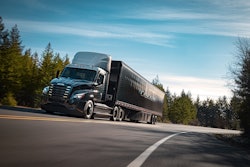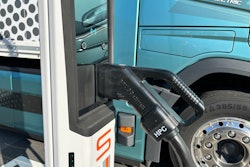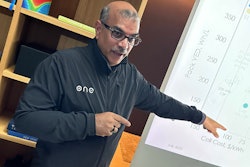Thankfully we are finally seeing real zero-emission trucks in real-world operations. I am constantly amazed at the world-record long-jump leaps of faith analysts and researchers make when promoting one drivetrain technology over another.
And don’t even get me started talking about inherent bias. If your organization or job title includes the words “hydrogen,” “nuclear,” “electric,” “renewable natural gas,” “renewable diesel,” or any of a thousand optimistic qualifiers such as “clean,” then just admit that there is at least some opportunity for bias to influence your work.
Wishful thinking is the world of paper trucks — those trucks that exist purely on paper, or more currently, in bits and bytes on computers. Paper trucks can do anything, anywhere, anytime. Reality can’t impact the projected capabilities of paper trucks, because they exist in a world of optimism. This is the world where all things are possible.
One of the great myths over the last several years is that a hydrogen-fueled truck weighs the same as the diesel that it replaces and that there is no potential freight loss from a hydrogen fueled vehicle. I’d love to know how they reached that conclusion since the actual weights of the day cab trucks are heavier than the comparable diesel vehicles on the road today.
In one recent first-hand experience, the manufacturer publicly stated that the weight of the fuel cell truck was identical to the comparable battery electric truck produced by the same corporation, both of which were on the show floor side-by-side for comparison. Both were, as expected, heavier than the comparable diesel. The potential range differed with the hydrogen fuel cell truck, perhaps twice that of the battery electric one, but diesel still outperformed both of them substantially on maximum range.
OEMs seem to go to some trouble to mask public release of actual tare weights of zero-emission vehicles (ZEVs), but fleets actually driving the vehicles should have no trouble knowing the actual weights as they run them across their scales. As that information begins to leak into the public, hopefully researchers take note and adjust their modeling and reports to more accurately reflect that all ZEVs weigh more than the diesels they are replacing, its just a matter of how much.
Another myth is that somehow battery electric trucks cannot go long distances while carrying commercially viable heavy loads. NACFE Run on Less – Electric DEPOT recently documented in early lessons learned that Class 8 BEVs can rack up significant daily miles while maxing out weight. Daily mileages with short en route charging sessions and slip seating drivers have exceeded 800 miles in one example. Distances of more than 400 miles per day are common from multiple participants.
One Class 8 OEM revealed to me last year that they had successfully exceeded 800 miles per day fully loaded running on their test track using short en route charging. While daily long-distance heavy loads require high-rate charging, they are proving to be possible.
A myth I frequently encounter is that somehow coal is generating all the electricity used in BEVs. I’m sure the coal industry would love that to be true. In the U.S., coal represented only 23% of the energy consumed creating electricity in 2022, according to tracking by the U.S. Department of Energy.
Myths exist on the diesel side as well. ZEV proponents seem to love to underestimate what diesels can do today, frequently citing average diesel fuel economy data that puts MPGs in the 6 MPG range. NACFE’s Run on Less 2017 showed that well driven current model year long haul tractors could exceed 10 MPG, and the 2019 Run on Less Regional demonstration showed exceeding 8 MPG was realistic in regional haul with heavy loads. The latest OEM model years are even better. Yet researchers and proponents of ZEVs seem to focus on comparing purchasing a new ZEV to very old diesels, which I assume means fleets can somehow only unrealistically buy old diesels.
One detailed analysis I sat through recently estimated a province’s potential on the number of vehicles registered in that province. A U.S. example would be counting the number of trucks operated in Indiana by saying all of the trucks with Indiana registration operate solely in Indiana. FYI, Federal Highway Administration data from 2016 indicated Indiana had the second highest truck tractor registrations in the U.S. Another study looked at a highway corridor and fundamentally assumed that all the trucks driving in that corridor only stayed in that corridor; that none were just passing through. Data can be misleading.
One of the challenges with the world of paper trucks is that arguing details is like debating philosophical beliefs. Those arguments are great for generating social media and investing buzz, but in the end those who agree can likely be equaled by those who disagree.
Since 2017, when the first Tesla semi was shown, the industry has wondered if Tesla trucks were able to do even half of what was promised. Many wondered if they were even going to be built. I’ve read endless articles over the years claiming they could not go long distances or carry useful loads along with endless articles that said they could do all that was promised.
Initial findings from Run on Less about the first few Tesla prototypes are promising, but wouldn’t it be great if these trucks were actually in series production? Wouldn’t it be great if we had long-term warranty data? Actual weights and costs? There seems still some paper in those trucks waiting on reality.
Some ZEV paper trucks are now real — built on actual production lines in OEM factories, supported by dealer networks — and can be both ordered and purchased. In other words, exposed to public scrutiny.
Real-world production trucks in real-world operation always provide ample factual detail. It need only be collected, hopefully moving us out of the realm of philosophy and into fact-based information.
I can’t wait for more reality in modeling as all the messy middle technologies hit the road and we see what they really can do. We should see real world battery electrics, hydrogen fuel cells, hydrogen ICE, greater use of renewable diesel and natural gas, and others.
Like a class reunion, we should plan on a 2030 roast of all the claims made versus reality for all the messy middle graduates. It would be enlightening.












